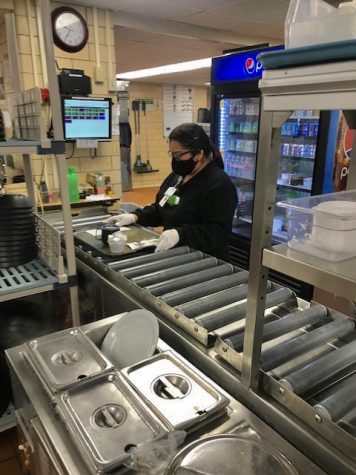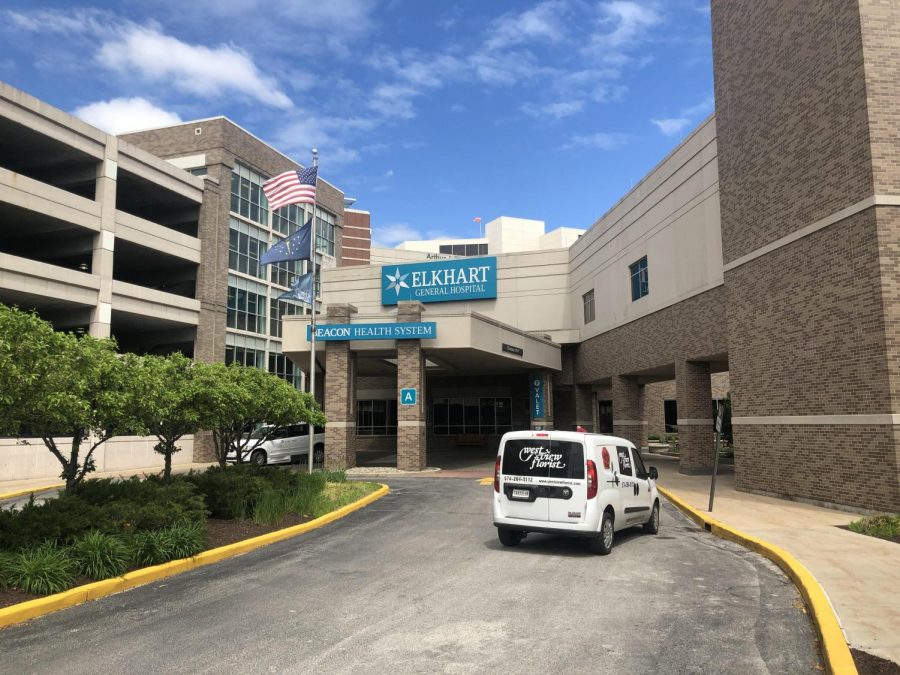Teens as essential workers in the midst of a pandemic
Elkhart General hospital on Thursday, May 21. During stay at home orders, teens were categorized as essential workers in grocery stores, pharmacies, hospitals, and convenience stores.
May 30, 2020
The changes COVID-19 has brought all across the world are undeniable, and obviously it has impacted the US economy at large, with the unemployment rate jumping all the way to 14.7% (around 22 millions people),the highest it has been since the 1930’s during the Great Depression. To say the least, not only is this pandemic a scary time for global health, but it is also a nightmare in terms of economic stability.
Whether one is a high school student or even in college, things still have to be paid for, and money still needs to be made to take care of all essential needs. But that is not always something that is realistic for all families. Parents lose their jobs in times like these and ends don’t always meet, and right or not, the bills still come.
The reality of it is that most upperclassmen have a job at some point for a multitude of reasons, and sure it’s easy to see how COVID-19 has impacted the adults of the population, but what about the working teenagers?
Senior Johnnie McCarey is a cashier at 7-Eleven.
“Before all of this, [the atmosphere] was a more laid back and simple environment where there weren’t many points in time where it was super stressful,” McCarey said.

At the 7-Eleven location where McCarey works, a big part of their course of action was installing proxy glass at each register to create a physical barrier of protection between the customer and the employee.
“Currently, 7-Eleven masks for workers are not required due to the proxy, but maybe they will require us to [wear them] in the future,” McCarey said.
Even though proxy glass is effective in preventing the spread of the virus, it has the opposite impact on customer service. It can easily be described as an obstacle for communication which makes McCarey’s job exponentially more difficult.
The masks that customers are advised to wear also add to the difficulty when it comes to communicating.
“It’s weird how a job you do for so long can change so quickly,” McCarey said.
Another change that the teenage workforce has been juggling is the number of hours they have been working. Some Elkhart businesses cut the hours of teenagers when the pandemic hit, but others saw them as essential employees and increased their hours.
Initially, McCarey was working less hours during the first month and a half of the stay at home order. With less people out and about, less workers were needed, so older associates with more necessity for money, such as independents with bills, were given the opportunity to make money. But with the city opening back up and more people traveling, he is back to his normal schedule.
Senior Hannah Smith is a cashier at Walgreens.
“Since the pandemic began, we now have to wear masks. We put up glass protectors at the register, and we have to clean the store three times a day,” Smith said.
Because of the shuttering of schools and her increased availability, Smith immediately began to work more than she did before the stay-at-home order. She has actually been working around 40 hour week since the pandemic was declared.
Walgreens is not a super store and they don’t often prepare to stock for sellouts, but with the increased need for items such as toilet paper, disinfecting spray and wipes, alcohol, hand sanitizer, and masks, it has been challenging to keep the shelves stocked.
“The changes are extremely stressful and customers have gotten progressively demanding over things we can’t control,” Smith said.
Junior Jessica Meza works at Elkhart General Hospital (EGH) as a food carrier.
“Before the COVID-19 changes happened, work was generally very busy. We had a high amount of patients which meant a high amount of food orders,” Meza said.
But when the pandemic hit, EGH shut down parts of the hospital to account for their priority patients, including COVID-19 patients. This actually resulted in Meza’s job to do the opposite of what she expected: with less patients, she had less meals to give out, making her job much slower than normal.
“When the pandemic hit, I was getting no hours until just recently,” Meza said.
Even though the food delivery aspect of her job is slower paced than before the pandemic, she isn’t bored. With a hospital being even more sterile than the average place, she is constantly cleaning and sanitizing her work space.
Working with a purpose

Most people work for a goal, different for each individual, and McCarey, Smith, and Meza all plan to attend college within the next two years which gives them something to strive for. But with the addition of COVID-19, plans change, and Meza found herself with even more responsibility on her chest.
“I needed to support my parents since the virus had them unemployed, where we had no income coming in, so I needed to help out,” Meza said.
The week that school officially closed for in person instruction was also the week that Meza’s parents got laid off at work. No work meant no income, and even though her family was prepared for minor emergencies, that preparation did not include a long term pandemic.
Additionally, parents of teenage workers were put in the position of deciding if the benefits of sending their child to work outweighed the risks. For parents like those of McCarey and Smith, they were concerned, but felt that with caution, their teens should take advantage of schools closing and use the time to make extra money. Meza’s parents, ironic of their situation, were against her going to work, but Meza felt they had no other option.
“Bills kept piling up and as we did quarantine shopping for groceries, the money we had kept going lower and lower until we barely had enough to pay bills,” Meza said.
The stress compounded when Meza helped her father file for unemployment, but with so many individuals applying for unemployment, their requests couldn’t be met fast enough.
“Thirty days after I went through the filing process with him, my step-dad still did not receive his unemployment check,” Meza said.
While payments eventually arrived, Meza’s job kept her family afloat when the unknown threatened to break them. Because of her job, she was able to help pay for groceries and protective equipment. Now, with everything slowly opening back up, Meza’s parents have returned to work and are finally able to get some of their normal income back.
“This time made me even more thankful that we have food and a roof over our heads and we are all healthy,” Meza said.
What does the future hold?
But how do those students on the front line of the workforce feel about their future and the impact COVID-19 will have on their job?
“Personally, I think that these ‘changes’ are going to be the new normal,” Meza said. “This whole virus thing is here for the long run and as long as we wear the safety equipment and take extra precautions, we should be fine. Which, these are precautions we should be taking anyways working in a hospital. But the end definitely does not look near. This will be here for awhile.”








